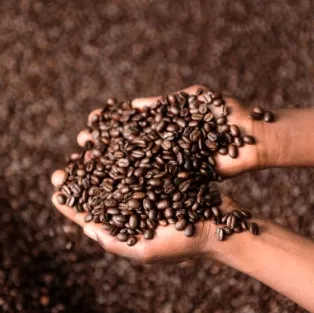For many consumers, the morning routine begins with a comfortable cup of coffee, refreshing their minds and starting the day. The coffee industry puts large efforts into roasting beans, since it is a critical process deciding final outputs’ rich flavors, deep colors, and charming aromas. However, this carefully cultivated quality faces a huge challenge: air exposure to oxygen. Once roasting is complete, contact with oxygen begins to degrade the coffee, rapidly diminishing the roasted coffee’s shelf life and causing the loss of flavor. That’s why nitrogen packing machines were invented, offering an effective solution by replacing oxygen with pure nitrogen during the coffee packaging process, ultimately preserving the precious freshness and flavor of your beloved brew.
What is Nitrogen?
Nitrogen, a diatomic nonmetal, is a colorless, odorless, and largely unreactive gas that constitutes approximately 78% of Earth’s atmosphere. Its inert nature stems from the strong triple bond between its two atoms, requiring significant energy to break. This lack of reactivity makes it an ideal inert gas for food packaging, preventing unwanted chemical reactions like oxidation that degrade food quality. In the context of coffee, this inertness is crucial in preserving the volatile aromatic compounds and oils that define its unique flavor profile. By displacing oxygen with nitrogen, it creates an environment where these delicate compounds are shielded from deterioration, effectively extending the shelf life of nitrogen-flushed coffee.
We can not exactly trace the person or company that first found and implemented nitrogen flushing suitable for coffee products, according to available records online. Using gas inside food packages indeed has a long history and is widely applied by many large manufacturers. The application of modified atmosphere packaging (MAP), where the air in a package is replaced with a gas or gas mixture (often including nitrogen), has been utilized in the food industry for various products to extend shelf life and maintain quality.
Nitrogen & Coffee Package
Why Oxygen Degrades Coffee Quality
Have you ever realized a bag of coffee beans or coffee grounds that lacked aroma and tasted disappointingly stale after some time? This is because of oxidation, the reaction of coffee compounds with oxygen in the air. Coffee beans, in essence, are seeds. Seeds are continuously breathing to prevent dying, as well as coffee beans. Along with breathing, these coffee beans oxidize and transform their original chemical composition. The external parts of coffee bean cells contain oil, which quickly oxidize and become rancid. This is the second factor that affects the coffee quality during contact with air. So we will find
- Loss of Coffee Aroma: The delicate aromatic compounds that contributed to coffee’s appealing scent disappeared, resulting in a less vibrant and disappointing cup of coffee after brewing.
- Coffee Staling: Exposure to oxygen directly accelerates the staling process of roasted coffee, often within just weeks or even days later.
How Nitrogen Protects Coffee
To resolve the negative effects of oxygen, the coffee industry adopts nitrogen, which is an inert gas that doesn’t react with coffee’s compounds. Adding nitrogen directly displaces the oxygen and pushes the oxygen out of the coffee package during the nitrogen flushing process. By replacing oxygen with nitrogen, a modified atmosphere is created within the packaging, significantly slowing down oxidation. Nitrogen does not chemically react with the coffee, ensuring it doesn’t negatively alter the taste or aroma.
The application of food-grade nitrogen for coffee extends beyond just the final packaging. It plays a vital role in several steps.
- Preserving Freshness When Store Bulk Coffee Beans: Freshly roasted coffee beans with volatile aromatics are usually stored in an airtight environment for a limited time before the next step of To ensure their peak freshness and the oxygen concentration remains at a critical level, they undergo regular nitrogen gas purging. This process prevents premature staling and ensures the coffee beans retain their quality until they arrive at the packaging line
- Nitrogen Flushing: The standard coffee packaging process, whether whole beans or ground coffee, involves a nitrogen flushing step. The nitrogen flushing effectively removes oxygen and minimizes moisture within the single package. It helps guarantee the consuming experience, even weeks or months after packaging. Especially to dedicated coffee lovers, the high-quality flavor and aroma decide whether they will become your loyal customers.
- Nitrogen-Flushed Coffee Capsules and K-Cups: The effective technique of nitrogen flushing coffee is also applied to single-serve coffee products. Coffee Capsules like Nespresso, Dolce Gusto, and K-Cups can go through the nitrogen flushing process during production. Advanced automatic single coffee capsule packaging machines with nitrogen flushing functions are available on the market. Coffee Roasters could invest in an automatic fill-seal machine and professional nitrogen generators.
Key Benefits of Marketing Aspects
We usually talk about how coffee roasters would be beneficial from nitrogen flushing and what benefits nitrogen flushing brings to packaged coffee, technically. Have you ever considered whether consumers could understand and pay these premiums? So, let us discuss how to tell consumers the pros of nitrogen-flushed coffee in their language!
“Freshness Promise” – A Tangible Selling Point:
- “Experience coffee as fresh as the day it was roasted!” Nitrogen flushing allows coffee roasters to make this advertising campaign confidently, since it is a tangible benefit to consumers who value quality at first and presume truly fresh, packaged coffee.
- This strong selling point can justify a premium price compared to conventionally packaged coffee. It attracts discerning customers willing to pay more for superior quality, directly increasing revenue per sale.
Building Brand Trust and Loyalty:
- By investing in nitrogen flushing, you’re signaling to your customers that you prioritize quality and are willing to go the extra mile to deliver the best possible product. This builds trust and fosters brand loyalty. Customers who consistently enjoy fresh, flavorful coffee from you are more likely to become repeat buyers.
- Loyal customers have a higher lifetime value. They make repeat purchases, are less price-sensitive, and are more likely to recommend your brand to others, reducing customer acquisition costs and increasing overall profitability.
Differentiating Your Brand in a Crowded Market:
- In a competitive coffee market, nitrogen flushing can be a key differentiator. Highlighting this preservation technique in your packaging, website, and marketing materials can set you apart from competitors who don’t offer the same level of freshness guarantee.
- Differentiation allows you to carve out a unique position in the market, attract a specific customer segment that values freshness, and potentially command a larger market share.
Expanding Your Reach Without Sacrificing Quality:
- The extended shelf life provided by nitrogen flushing opens up new marketing and distribution channels. You can confidently sell your coffee online, ship it across longer distances, and partner with retailers who might have hesitated due to concerns about freshness.
- Access to broader markets significantly increases your potential customer base and sales volume, leading to higher overall profits.
Reducing Negative Feedback and Returns:
- Stale coffee leads to disappointed customers and negative reviews. By ensuring consistent freshness, nitrogen flushing minimizes the risk of negative feedback and costly returns.
- Protecting your brand reputation through consistently high-quality products leads to better customer retention and reduces the costs associated with handling complaints and returns.
Creating Engaging Marketing Content:
- Nitrogen flushing provides a compelling story to tell your customers. You can educate them about the benefits of this technology and how it contributes to the superior taste and aroma of your coffee. This can be used in blog posts, social media content, and in-store displays to engage consumers.
- Profit Benefit: Engaging content drives customer interest and can lead to increased sales and brand awareness.
Nitrogen Flushing & Coffee Capsule Shelf Life
The nitrogen flushing can extend the shelf life of coffee capsules, compared to those without this protective action. Let’s break down the details:
- Coffee Capsules Without Nitrogen Flushing: The high contact surface of ground coffee leads to oxidation and a rapid decline in quality. Oxygen exposure initiates staling within weeks or even days. The appealing scent fades quickly, impacting the overall consumer brewing experience and your brand reputation.
- Coffee Capsules With Nitrogen Flushing: Oxidation is effectively decreased, allowing freshness to be maintained for 12 to 24 months. The original roasted aroma and charming flavor notes retain for a relatively longer period, which is beneficial to freshness and extraction. It also helps customer repurchase rates as well as sales revenues.
Understanding Coffee Capsule Shelf Life Without Nitrogen Flushing
Without the nitrogen flushing, the shelf life of coffee capsules is generally shorter.
- Week 1- week 4: Initial freshness is mostly retained, but oxidation
- Month 2 – Month 4: Aroma and flavor decline
- After 4 Months: Coffee might become completely stale
Additional Factors Affecting Coffee Capsule Quality and Shelf Life
- Packaging Material
- Light Exposure
- Heat
- Grind Size
- Initial Coffee Quality
- Shipping Period
- Shelf Life
- Post-Purchase Storage
How Could SANEU Help With Your Coffee Aroma
One of our core strengths is the wide range of nitrogen flushing coffee capsules packaging machines. Nitrogen is critical for preserving the aroma, flavor, and overall quality of coffee/tea by replacing oxygen and preventing oxidation. We offer various machines designed to integrate nitrogen flushing seamlessly into the packaging process for different private coffee capsules, such as Nespresso, K-Cup, Dolce Gusto, and Lavazza. The nitrogen flushing function directly addresses the critical need for extended shelf life and maintaining the coffee aroma as just roasted, allowing businesses to reach wider overseas markets, generate higher sales revenue, reduce sales return rates, ensure customer satisfaction, build a strong brand reputation, and earn loyal customers.
For businesses just stepping into or expanding their product line to single-serve coffee capsules, we provided specialized K-cup/Nespresso/Dolce Gusto/private label capsules filling and sealing machines integrated with nitrogen flushing technology. Besides, we have various-sized nitrogen generators available. These machines automate the process of filling coffee grounds into empty pods and hermetically sealing them to maintain freshness. The inclusion of nitrogen flushing in these machines is a significant advantage, allowing brands to offer single-serve coffee that rivals the freshness of whole bean or ground coffee packaged immediately after roasting.
The standard nitrogen level widely applied in the coffee industry to coffee capsules is to achieve a residual oxygen level of less than 5%, with many high-quality producers striving for 3%. The goal is to create an inert atmosphere that significantly minimizes the presence of oxygen, which is the primary cause of coffee staling. However, we, SANEU, manufacture the coffee capsule filling machines to achieve higher nitrogen content within the sealed capsule, aiming for the low residual oxygen levels mentioned above ( 99.5% plus nitrogen content). By utilizing SANEU’s technology, coffee and tea companies could market their products as having superior freshness and extended shelf life, differentiating themselves in a competitive market.







